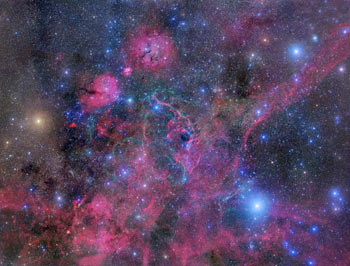by Ann » Fri Sep 24, 2010 7:20 pm
That's a wonderful picture, Marco Lorenzi. Exactly my kind of picture too. Puppis is a very beautiful constellation, full of interesting nebulosity and noteworthy stars, the greatest of which is O5 supergiant Zeta Puppis.
In your image you have captured a lot of fascinating cometary globules. And just like the kind of comets that we know in our own solar system, the cometary globules have "tails" that "point away" from a sun. What sun is that? What sun is responsible for creating all those cometary globules with tails all pointing in the same direction, to the right in the image? Is the "cometary-blowing star"Zeta Puppis? It doesn't look that way to me. Instead, it appears that all the cometary globules here have their tails pointing away from Gamma Velorum. Gamma Velorum is one of the most extreme stars in the moderately nearby part of the galaxy, because it is considerably nearer to us than Eta Carina. Gamma Velorum is an incredible binary star, made up of one O-type supergiant and one super-hot Wolf Rayet star.
So if you look closer at the cometary globules in Marco Lorenzi's picture, you'll see that they all have their tails "blown to the right". And indeed, Gamma Velorum would be to the left here, even though it is too far to the left to show up in the picture.

This is the Vela supernova remnant by Robert Gendler. Note the very bright blue star at lower right, at about five o'clock. That's Gamma Velorum, the star responsible for blowing all the cometary globules in Puppis. The second brightest blue star in the picture, at upper right at about two o'clock, is Zeta Puppis. The Puppis skyscape with all the cometary globules photographed by Marco Lorenzi would be off the frame to the right here.
This is David Malin's famous picture of the cometary globule that is called "hand of God" in Marco Lorenzi's image.
Also note galaxy NGC 2427 in Marco Lorenzi's image. It's a wonder that we see much of this galaxy at all, since there is so much Milky Way gas and dust between the galaxy and us. I apologize for the bad picture here, but that was the best I could do!

Ann
That's a wonderful picture, Marco Lorenzi. Exactly my kind of picture too. Puppis is a very beautiful constellation, full of interesting nebulosity and noteworthy stars, the greatest of which is O5 supergiant Zeta Puppis.
In your image you have captured a lot of fascinating cometary globules. And just like the kind of comets that we know in our own solar system, the cometary globules have "tails" that "point away" from a sun. What sun is that? What sun is responsible for creating all those cometary globules with tails all pointing in the same direction, to the right in the image? Is the "cometary-blowing star"Zeta Puppis? It doesn't look that way to me. Instead, it appears that all the cometary globules here have their tails pointing away from Gamma Velorum. Gamma Velorum is one of the most extreme stars in the moderately nearby part of the galaxy, because it is considerably nearer to us than Eta Carina. Gamma Velorum is an incredible binary star, made up of one O-type supergiant and one super-hot Wolf Rayet star.
So if you look closer at the cometary globules in Marco Lorenzi's picture, you'll see that they all have their tails "blown to the right". And indeed, Gamma Velorum would be to the left here, even though it is too far to the left to show up in the picture.
[img]http://www.guidetothecosmos.com/images/gendler3e-vela_snr.jpg[/img]
This is the Vela supernova remnant by Robert Gendler. Note the very bright blue star at lower right, at about five o'clock. That's Gamma Velorum, the star responsible for blowing all the cometary globules in Puppis. The second brightest blue star in the picture, at upper right at about two o'clock, is Zeta Puppis. The Puppis skyscape with all the cometary globules photographed by Marco Lorenzi would be off the frame to the right here.
[img2]http://apod.nasa.gov/apod/image/0210/cg4_aao_big.jpg[/img2]
This is David Malin's famous picture of the cometary globule that is called "hand of God" in Marco Lorenzi's image.
Also note galaxy NGC 2427 in Marco Lorenzi's image. It's a wonder that we see much of this galaxy at all, since there is so much Milky Way gas and dust between the galaxy and us. I apologize for the bad picture here, but that was the best I could do!
[img]http://www.tian12.com/data/ngcic_image/imagedata_ngc2/ngc_2427.jpg[/img]
Ann